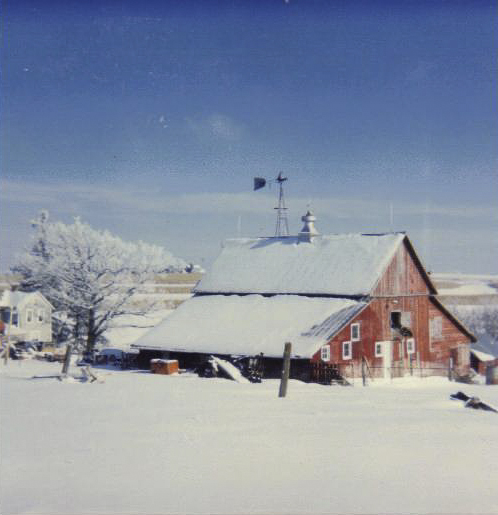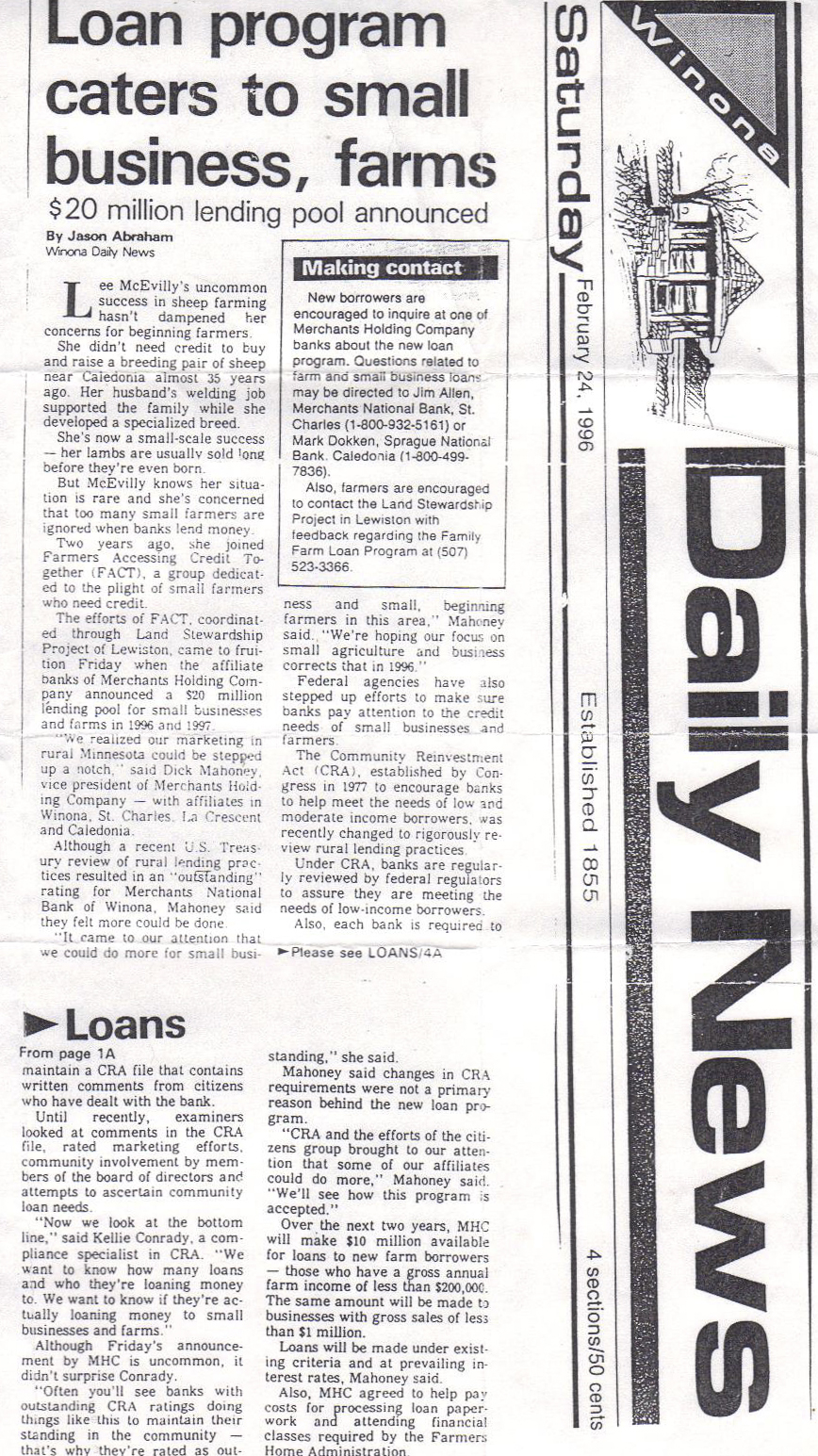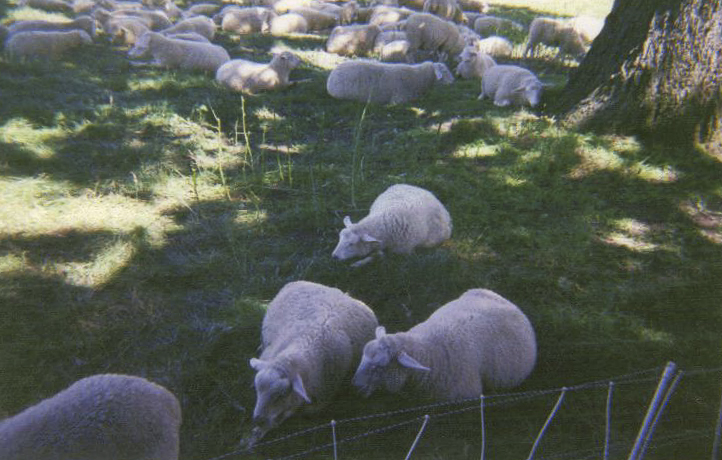1996
After Jerry’s detached retina surgery at Christmas time, 1995, we launched into a month of four different types of eye drops every hour, and frequent visits to the eye surgeon in La Crosse. Finally, Jerry began to get some sight back, but he still had the racking cough, and refused to see a doctor. about that. Soon, he began to have severe pain, first here, then there, which he blamed on his back being “out.”
1996 was not getting off to a good start, as in mid-January, our submersible pump quit. This entailed getting a huge well pulling truck in to “pull the pump.”
 No mean feat, as just getting to the well site in the snowy winter was a problem, then slowly pulling 515 feet of pipe, a tedious and time consuming job. It turned out the pump was shot, and had to be replaced at close to $2,000 by the time everything was back in place. But we had water again!
No mean feat, as just getting to the well site in the snowy winter was a problem, then slowly pulling 515 feet of pipe, a tedious and time consuming job. It turned out the pump was shot, and had to be replaced at close to $2,000 by the time everything was back in place. But we had water again!
Fortunately, the ewes ate snow, and only the penned up rams needed to be watered, which I managed with an old cistern below the barn which had once supplied water to the house.
Finally, Lisa and I were taking Jerry for his last eye check up in La Crosse, and on the way home we talked him into going by our family doctor in Caledonia to get that cough checked out. But when we neared Caledonia he said he could not go to the doctor, he was in too much pain and just wanted to get home.
Later that night, after Lisa had returned to Rochester, the pain became so severe that Sean and I took him to the emergency room at St. Francis Hospital in La Crosse. It is still hard to understand, with the cancer as advanced as it was, why it took four days in the hospital to find “something” in his lungs, and several more days of tests to confirm that he had terminal lung cancer.
Our doctor called and asked me to bring Jerry in so he could talk to him first hand about the diagnosis.
It was a terrible day, very cold and windy, with huge snow drifts everywhere. Sean and I had to almost carry him between us to get him out to the car. I’m sure he knew all along what the outcome would be.
The doctor told him what the prognosis was, and that he would probably live about two months, possibly three, but we would have the Hospice plan so he could be in his own home, which was his wish.
The Hospice people were wonderful, and came every day to check on him and do everything they could to make him comfortable. We had everything that could be done to control the pain, but I could see that he just wanted to get it over, and with his strong will, he just started shutting his body down.
I told the Hospice Nurse this, and that I didn’t think he would live very much longer, but she thought he had a lot of body mass left and would live quite awhile. Ten days after he heard the diagnosis from our doctor, he was dead.
We, as a family, somehow got through it all with the help of the Hospice Chaplain, the support of the VFW, the Sustainable Farming Association (SFA) members, and many friends, and found that eventually, life goes on. It was good that Sean had recently changed jobs and was working close to home during this time.
 Strangely enough, two days after the memorial service, when some SFA and Land Stewardship Project (LSP) friends had stopped by to visit, a reporter from the Winona Daily News called and did a phone interview about Merchant’s Banks Holding Company agreeing to fund the Beginning Farmer Loan Program, which our LSP group had worked so long and diligently on. That was how I got the news that our efforts were finally successful!
Strangely enough, two days after the memorial service, when some SFA and Land Stewardship Project (LSP) friends had stopped by to visit, a reporter from the Winona Daily News called and did a phone interview about Merchant’s Banks Holding Company agreeing to fund the Beginning Farmer Loan Program, which our LSP group had worked so long and diligently on. That was how I got the news that our efforts were finally successful!
Farming, especially where animals are concerned, does not allow one to spend a lot of time grieving. After a few days when friends stopped in to help with chores, it was time to get back into my shepherd’s role and do what needed to be done.
Shearing had been scheduled earlier in February, but had to be cancelled with all that was going on. It was now set for March 9, a little closer to lambing than I would have wished, but it was the best we could do.
We had not been able to identify, with any certainty, the source of the abortion outbreak the previous year. Since the Texel ram lamb had bred all the ewe lambs, he was the most likely suspect. He was an excellent ram in every other aspect so it was hard to make a decision on whether to keep him or get rid of him. After some serious consideration in the fall of ’95, I decided to “bite the bullet” and breed him to the mature ewes, but it was still a concern pre-lambing.
Lambing commenced near the end of March, and thankfully, no abortions occurred. I was immensely relieved and happy that my Texel ram was no longer suspect! However, we were still in the dark as to where the infection had come from.
Lambing actually went very well, and the lambs were beautiful and sturdy, showing the Texel breeding, with the characteristic double hind leg muscle already apparent.
The young ewes, lambing a few weeks later, many of which had aborted the previous year, also had no recurrence of that this year, and I felt extremely lucky!
When the flock went to pasture in late April, we ran them through the “woods pasture” to graze off the early shoots of burdock. It had been pretty well eradicated, but we did not want it to make a comeback, as the nasty burrs it produced could turn a beautiful fleece into a burry mess which was totally worthless.
The flock was only in that pasture for a few days, but that was long enough for three lambs to disappear! The coyotes were off to a great start, and it looked like a tough year ahead!
Later that month the flock was back on regular pasture rotation, and when I was moving fences I saw a bunch of lambs playing “king of the hill” on what appeared to be several gopher mounds some distance away. The next time I went to move fences I was close to the place where I had seen the lambs playing, and went to look it over as I had been working to eradicate gophers from the pastures, and didn’t want them to begin digging again.
However, what had looked like gopher mounds from a distance away, I now saw was a badger’s den. I definitely did not want to meet up with the badger, as they are not very sociable! While I was walking gingerly around examining the mound which had two holes, apparently an entrance and an exit, I heard a scrabbling noise coming from inside the mound. I thought the badger was on his way out! My ATV was nearby, as I had hauled fences out on it, so I quickly jumped on it and went home.
The next day I was back to move fences again, and when I was near the badger den, I went fairly close to examine it further, carefully! The badger did not seem to be in residence, so I edged closer and looked into one of the holes. It was quite dark in the hole, but I thought I could see something in there! I kept peering into the hole, and I was pretty sure what I saw wasn’t a badger. It was a dusty grey, but not the color of a badger.
Finally I got down on my knees and looked very hard, whatever was in the hole never moved. All of a sudden, the memory of the lambs playing on the mound leaped into my mind, and I realized this was a lamb which had fallen into the hole during the game of “king of the hill,” and that was what was making the scrabbling noise the night before, as it tried to escape.
It was wedged so tightly it could not move. All that was visible were the hind quarters, no legs… they were apparently turned forward.
I was quite sure the lamb was dead by this time, but I began trying to work my hands along each side of the butt. I could not get any hand hold, but finally I got my hands worked past the hip bones and could then begin to try and work the lamb backward to free it. It seemed to take forever, but unbelievably when I at last had the lamb extracted, it was still alive!
It had been in that hole so long that its body was stiff and it could not move at all for some time. I massaged its body and legs and eventually it began to move a little. I held it in front of me on the 4-wheeler and took it back to the barn, then went to find the lamb’s mother and its twin. I carried the twin, with the ewe following, back to the barn and penned them with the rescued lamb.
By late afternoon the lamb’s muscles had relaxed enough that it was able to stand with help and nurse its mother. Once that was achieved, it soon regained strength and balance, and after a couple days they were all back with the flock… a small victory!
 June went well, with no more losses to coyotes since we were grazing the regular fenced paddocks. Near the end of the month the flock was brought in for weaning. We had 210 sheep in the flock at that point.
June went well, with no more losses to coyotes since we were grazing the regular fenced paddocks. Near the end of the month the flock was brought in for weaning. We had 210 sheep in the flock at that point.
By early July lamb sales were underway, with 35 ewe lambs and one ram lamb going to SEMSPA friends, and they would take 15 more ewe lambs when the second group of lambs was weaned two weeks later.
In the midst of all the confusion of weaning groups of lambs, followed by lamb sales, a group enrolled in the Sheep Management School at Hawkeye Tech in Waterloo, IA, came for a tour on July 13. They were on an extended trip to various sheep related enterprises in IA, MN, and WI.
This was a very focused group, including grazers and fencing contractors. We had a very good afternoon, with lots of questions, and comments. Several sent thank you notes later saying our farm was the highlight of the whole trip!
High praise, indeed!

Wow, what a year. I am so sorry about the loss of your husband- and to have all the farm responsibilities on top of that. It can be good to keep busy but grief is so utterly exhausting that sometimes it is hard to find any energy to do the bare necessities. My heart is with you for that hard time. That is why it must have been so sweet to have saved that baby lamb- what a brave woman you were and how good it must have felt to have the little lamb get healthy again. As far as the loan program and the tour, think of all the people’s lives you have influenced in the farming realm- your work and your farm has truly made a difference in people’s lives. You still are with your stories of life on the farm. Thank you for sharing!
Sands,
Appreciated your thoughtful comment! It was indeed a trying time in our lives, but as the saying goes, “Whatever doesn’t kill you, will make you stronger.” There may be some truth in that, but it’s a hard way to gain strength!
Moments like saving the lamb that was trapped in the badger hole were bright spots of happiness, as there were many times when one was unable to save a beloved animal, try as you might. Losing lambs and ewes to coyote kills were some of the most bitter times to deal with, and made you feel so inadequate.
I do hope these stories can help people understand more about farming, and are perhaps are informative to persons who might be interested in raising livestock, grazing, conservation, etc.
Keep reading, there are happier days ahead, and of course, some new challenges!
Lea